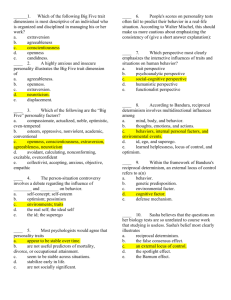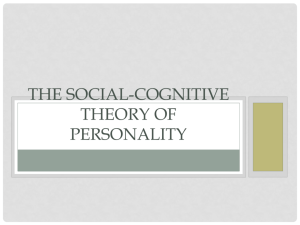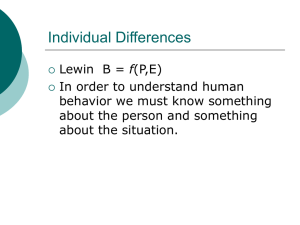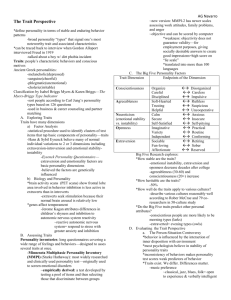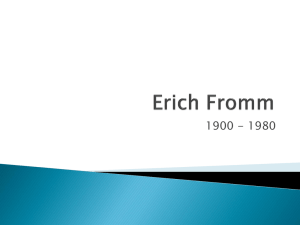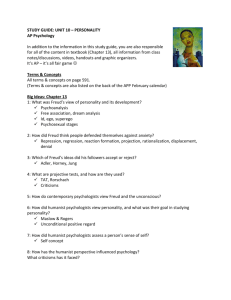Directions: On a separate piece of paper to be turned in for credit, #1
advertisement
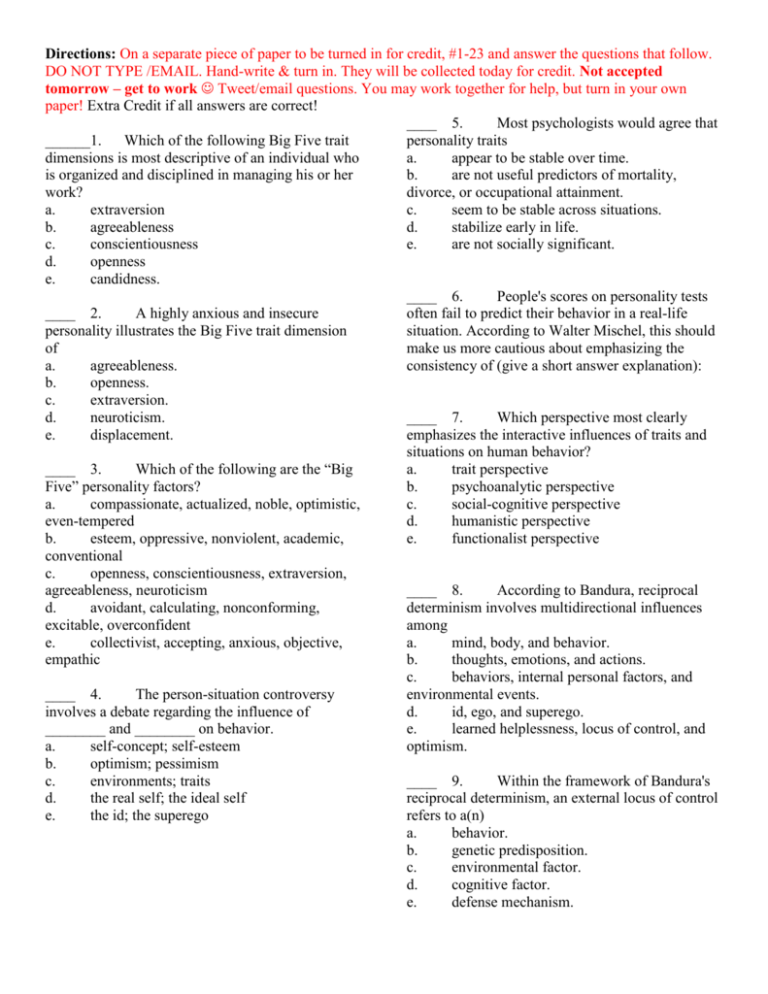
Directions: On a separate piece of paper to be turned in for credit, #1-23 and answer the questions that follow. DO NOT TYPE /EMAIL. Hand-write & turn in. They will be collected today for credit. Not accepted tomorrow – get to work Tweet/email questions. You may work together for help, but turn in your own paper! Extra Credit if all answers are correct! ____ 5. Most psychologists would agree that ______1. Which of the following Big Five trait personality traits dimensions is most descriptive of an individual who a. appear to be stable over time. is organized and disciplined in managing his or her b. are not useful predictors of mortality, work? divorce, or occupational attainment. a. extraversion c. seem to be stable across situations. b. agreeableness d. stabilize early in life. c. conscientiousness e. are not socially significant. d. openness e. candidness. ____ 6. People's scores on personality tests ____ 2. A highly anxious and insecure often fail to predict their behavior in a real-life personality illustrates the Big Five trait dimension situation. According to Walter Mischel, this should of make us more cautious about emphasizing the a. agreeableness. consistency of (give a short answer explanation): b. openness. c. extraversion. d. neuroticism. ____ 7. Which perspective most clearly e. displacement. emphasizes the interactive influences of traits and situations on human behavior? ____ 3. Which of the following are the “Big a. trait perspective Five” personality factors? b. psychoanalytic perspective a. compassionate, actualized, noble, optimistic, c. social-cognitive perspective even-tempered d. humanistic perspective b. esteem, oppressive, nonviolent, academic, e. functionalist perspective conventional c. openness, conscientiousness, extraversion, agreeableness, neuroticism ____ 8. According to Bandura, reciprocal d. avoidant, calculating, nonconforming, determinism involves multidirectional influences excitable, overconfident among e. collectivist, accepting, anxious, objective, a. mind, body, and behavior. empathic b. thoughts, emotions, and actions. c. behaviors, internal personal factors, and ____ 4. The person-situation controversy environmental events. involves a debate regarding the influence of d. id, ego, and superego. ________ and ________ on behavior. e. learned helplessness, locus of control, and a. self-concept; self-esteem optimism. b. optimism; pessimism c. environments; traits ____ 9. Within the framework of Bandura's d. the real self; the ideal self reciprocal determinism, an external locus of control e. the id; the superego refers to a(n) a. behavior. b. genetic predisposition. c. environmental factor. d. cognitive factor. e. defense mechanism. ____ 10. Sasha believes that the questions on her biology tests are so unrelated to course work that studying is useless. Sasha's belief most clearly illustrates a. reciprocal determinism. b. the false consensus effect. c. an external locus of control. d. the spotlight effect. e. the Barnum effect. ____ 11. Laura fails to recognize any connection between her unsafe sexual practices and the likelihood of contracting a sexually transmitted infection. Laura's lack of perceptiveness best illustrates the dangers of a. free association. b. the self-reference phenomenon. c. the spotlight effect. d. an external locus of control. e. unconditional positive regard. ____ 12. An individual who perceives an internal locus of control would most likely show signs of a a. weak id. b. strong id. c. weak ego. d. strong ego. e. weak superego. ____ 13. Learned helplessness is MOST likely to be associated with a. self-serving bias. b. an external locus of control. c. the false consensus effect. d. unconditional positive regard. e. the spotlight effect. ____ 14. Compared with those who made a purchase choice from among 30 different brands of jam or chocolate, those who chose from among just 6 brands expressed more satisfaction with their choice. WHY??? ____ 15. Compared with European-American students, Asian-American students express a somewhat greater ________ about their future performance, which may help to explain their impressive academic achievements. a. unconditional positive regard b. self-serving bias c. false consensus effect d. pessimism e. optimism ____ 16. Excessive self-confidence is especially likely to be facilitated by the difficulty in recognizing a. personal control. b. free association. c. one's own incompetence. d. unconditional positive regard. e. superego. ____ 17. The best indicator of a person's level of optimism is his or her a. ideal self. b. gender identity. c. attributional style. d. unconditional positive regard. e. self-esteem. ____ 18. According to the social-cognitive perspective, one of the best ways to predict a person's future behavior is to a. identify that person's most central traits by having him or her take a personality inventory. b. observe that person's behavior in various relevant situations. c. assess that person's general level of selfesteem. d. uncover that person's hidden motives, as revealed by projective tests. e. measure that person's unconscious conflicts and use of defense mechanisms. ____ 19. Which of the following personality assessments would most likely be used by socialcognitive psychologists? a. asking test-takers to describe a series of inkblots b. administering an objective inventory that measures specific traits, such as extraversion c. observing and evaluating a student teacher's performance d. asking people to fill out questionnaires describing their ideal and real selves e. conducting an in-depth interview of a particular person ____ 20. A criticism of the social-cognitive perspective has been that it a. overestimates the importance of unconscious factors in personality. b. is inconsistent with research demonstrating the pervasive nature of self-serving bias. c. underestimates the importance of enduring personality traits. d. is inconsistent with the results of contemporary research on learning processes. e. overestimates the value of projective personality test scores. ____ 21. The social-cognitive perspective is LEAST likely to be criticized for neglecting the importance of a. environmental influences. b. unconscious motives. c. personality traits. d. genetic influences. e. the collective unconscious. SHORT ANSWER 1. Briefly explain how trait theorists develop and test theories such as the “Big Five” personality factors. 2. The personality traits that Tonya demonstrates at parties with her friends are very different from those she exhibits when she participates in class activities. Using your knowledge of reciprocal determinism to explain why the variability of Tonya's behavior in different situations is not surprising. 3. The behavioral psychologist B. F. Skinner emphasized that people are largely controlled by forces outside themselves. Critique the practical implications of personally accepting Skinner's position in light of contemporary research on locus of control.
